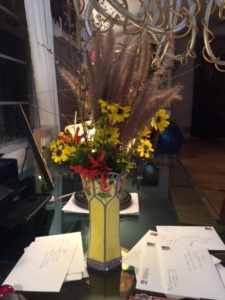 TS sent me the result of her outing today up in the mountains off Gibraltar Road, some handpicked wildflowers. She also found her great grandmother’s German yellow vase in which to place them on her table, to look at as she writes her holiday cards. She writes me, what is the era and style?
TS sent me the result of her outing today up in the mountains off Gibraltar Road, some handpicked wildflowers. She also found her great grandmother’s German yellow vase in which to place them on her table, to look at as she writes her holiday cards. She writes me, what is the era and style?
Pure Jugendstil, the German version of Art Nouveau, almost overnight, revolutionized modern design forever. Around 1890-1910 a magazine called Die Jugend (THE YOUNG) featured organic decorative art design for objects in the home, such as those on TS’s vase. As with many high-minded artistic movements, plenty of philosophy existed behind the style. These ideas emphasized that designs in decorative object should have “no reason for being” and little representational art. Compare this to the highly representational era which came before. For this reason you understand how easily the beginnings of the 20th century progressed from Jugendstil to geometric (think Bauhaus). So we see in Jugendstil the beginnings of abstract, modern design, beloved by every Millennial today.
Great Grandmother’s German Vase and Modernism
Her great grandmother’s vase must have felt at home surrounded by German Expressionist art in 1910. Later in the first quarter of the 20th century, the Bauhaus expanded on the theme of non-representational design. This led the 20th century forward thinker to believe in the non-organic design motifs of modernism.
The journey from Jugendstil to the Bauhaus became a short but interesting one. We consider Jugendstil, a branch of European Art Nouveau, but as in all German design a linear quality as well as a practicality of form exists behind it. The design may remain free flowing, but the form possesses a purpose. And it might be created in a factory.
I feel proud to say I come from a Germanic heritage. This typical blend of design and practicality I see today in my family, many of whom are engineers! I find a certain common sense, yet sentimental frivolity in Jugendstil, Notice the contrasting colors, anything but subtle. I see personality in the colors. Also consider that it’s not a piece of art, but a vase meant to hold flowers.
Along with the British designers of the era, the Jugendstil designers believed the aesthetic of interiors of buildings should blend creatively. Plus they should blend artistically for the education of those inside. The Germans called this a “ Gesamtkunskwerk,” a total environment of art. Because of this, and later like the artisans of the Bauhaus, all artisans became skilled in many mediums.
What we consider different about the German version of this European-wide aesthetic movement was that the Germans aimed to make artistic products. These could be factory produced, respectfully, of course, but commercially viable.
Interesting History of Jugendstil
The leading architect in 1890 schooled themselves in botany, so we see a relationship to Art Nouveau designers in France. Hermann Obrist designed and made furniture and ceramics for the 1899 Paris Exposition, to great acclaim.
How does one recognize Jugendstil?
- whiplash curves, set in a commercially produced format, like TS’s vase.
- marks of something hand made, but factory produced
- fresh but strident colors, and a certain unsubtle brashness never seen in French Art Nouveau.
- repetition of a theme, and repeating symbols, also seen in TS’s German vase.
Closely related to this was the Wiener Werkstatte, the Austrian answer to the synthesis of Avant Garde aesthetics and machine manufacturing. The Wiener Werkstatte borrowed and expanded upon the theme of the British Arts and Crafts Movement of the late 19th and early 20th century. They also borrowed from the French Art Nouveau artists, but unlike the British Arts and Crafts Movement, the Wiener Werkstatte artisans favored the machine made, and were superior architects.
Ironically, the result was the same: to make something by hand that was perfection, or to make something in design carried out by a machine and was perfection, expensive, and the designs made to “lift up” the people were unaffordable.
TS’s great grandmother’s vase, apart from giving me a taste of the Santa Barbara wildflowers in the mountains, is worth $400.
I have a set of German berry bowls that were passed down from my great great grandmother I would like to see if they have any monetary value to them there are six small bowls and one larger bowl. The stamp on the back says Germany and J S. They have scalloped sides with blue paint and pink roses in the center.
Pingback: W Stanley Davis Won Flower Shows - Elizabeth Appraisals